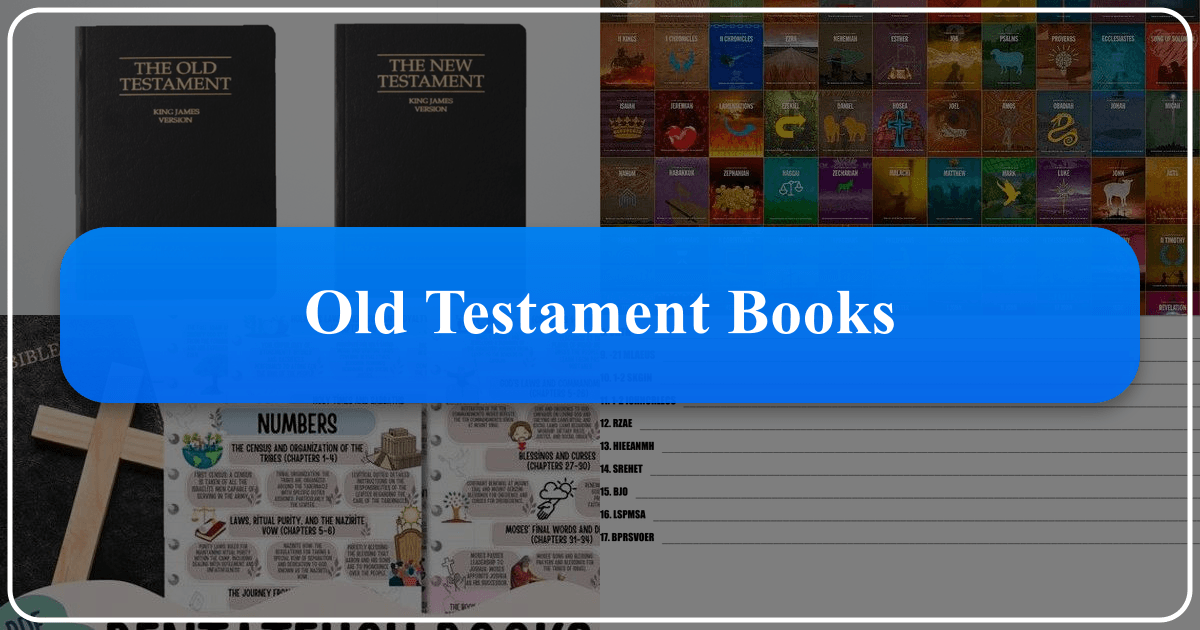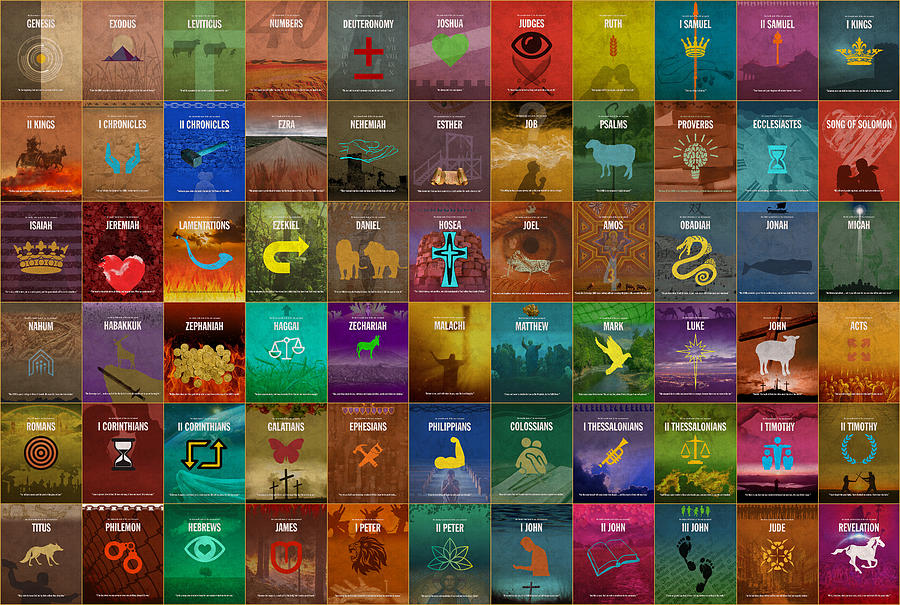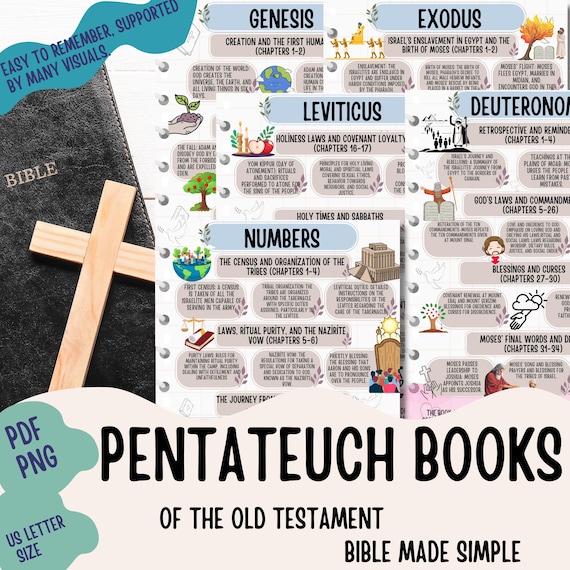Old Testament Books: A Comprehensive Guide

The Old Testament, a cornerstone of both Judaism and Christianity, comprises a collection of 39 books (in Protestant canons) that chronicle the history, laws, poetry, and prophecies of the ancient Israelites. However, the precise number and arrangement of these books vary depending on the religious tradition and the specific biblical canon followed. This guide provides a detailed exploration of the Old Testament books, examining their classification, authorship, historical context, and enduring cultural impact.

The Structure and Categorization of Old Testament Books
The Protestant Old Testament, consisting of 39 books, is traditionally divided into four main categories:
1. The Books of Law (Torah/Pentateuch):
These five books form the foundation of Jewish law and religious practice. They are also known as the Torah in Hebrew and the Pentateuch in Greek. These books narrate the creation of the world, the covenant between God and Abraham, the exodus from Egypt, the giving of the Law at Mount Sinai, and the Israelites’ journey toward the Promised Land.

-
Genesis: This foundational text recounts the creation of the universe, the first humans, the flood, and the early patriarchs, laying the groundwork for the subsequent narratives. Key themes include creation, the fall of humanity, covenant, and promise.
-
Exodus: This book details the liberation of the Israelites from slavery in Egypt, their journey through the wilderness, and the revelation of the Ten Commandments at Mount Sinai. Key themes include liberation, covenant, and theophany.
-
Leviticus: Primarily focused on priestly laws and rituals, Leviticus outlines the regulations for sacrifices, festivals, and purity, emphasizing holiness and the relationship between God and the Israelite people. Key themes include holiness, ritual purity, and sacrifice.
-
Numbers: This book describes the Israelites’ census, their journey through the wilderness, and their rebellion against God. Key themes include census, wandering, disobedience, and God’s faithfulness.
-
Deuteronomy: This book, essentially a reiteration of the Law, includes Moses’ final addresses to the Israelites before their entry into Canaan. Key themes include covenant renewal, obedience, and justice.
2. The Historical Books:
These 12 books narrate the history of the Israelites from their conquest of Canaan to the period of the Persian empire. They provide a chronological account of significant events, including military campaigns, social structures, and the reigns of various kings.
-
Joshua: This book recounts the conquest of Canaan under the leadership of Joshua, the successor of Moses. Key themes include conquest, land inheritance, and obedience.
-
Judges: The book of Judges describes a period of cycles of oppression and liberation, led by various judges who delivered the Israelites from their enemies. Key themes include cycles of sin and redemption, and the role of leadership.
-
Ruth: This heartwarming story focuses on Ruth, a Moabite woman who displays unwavering loyalty to her mother-in-law Naomi. Key themes include loyalty, redemption, and kinship.
-
1 Samuel: This book details the establishment of the Israelite monarchy, focusing on the reigns of Saul and David, highlighting the transition from a tribal society to a kingdom. Key themes include the rise of the monarchy, prophecy, and leadership.
-
2 Samuel: This continuation of the story of David’s reign explores his triumphs and failures, highlighting the complexity of his character and the challenges of leadership. Key themes include kingship, David’s rise and fall, and covenant.
-
1 Kings: This book narrates the reigns of Solomon and subsequent kings of the united kingdom of Israel, emphasizing the construction of the Temple in Jerusalem and the subsequent division of the kingdom. Key themes include the wisdom of Solomon, the division of the kingdom, and the importance of the temple.
-
2 Kings: This book covers the reigns of the kings of Israel and Judah following the division of the kingdom, eventually leading to the exile of both kingdoms. Key themes include kingship, idolatry, and judgment.
-
1 Chronicles: This book offers a genealogical and historical account of the Israelite people, primarily focusing on the lineage of David and the establishment of the kingdom. Key themes include genealogy, kingship, and the Davidic covenant.
-
2 Chronicles: Similar to 1 Chronicles, but with a greater focus on the kings of Judah and the role of the temple in Jerusalem. Key themes include the temple, kingship, and worship.
-
Ezra: This book describes the return of the Jewish exiles from Babylon and the rebuilding of the Temple in Jerusalem. Key themes include restoration, rebuilding, and obedience to the law.
-
Nehemiah: This book details the rebuilding of the walls of Jerusalem under the leadership of Nehemiah. Key themes include rebuilding, leadership, and faithfulness.
-
Esther: Set in the Persian Empire, this book tells the story of Esther, a Jewish queen who saves her people from annihilation. Key themes include deliverance, courage, and divine intervention.
3. The Poetic Books:
These five books express a wide range of emotions, reflections, and wisdom through poetic forms.
-
Job: This book explores the problem of suffering and the nature of divine justice through the story of Job, a righteous man who endures immense hardship. Key themes include suffering, justice, and faith.
-
Psalms: A collection of 150 hymns and prayers, expressing diverse emotions and beliefs. Key themes include praise, lament, and trust in God.
-
Proverbs: A collection of wise sayings and maxims offering guidance for righteous living. Key themes include wisdom, justice, and morality.
-
Ecclesiastes: This philosophical book explores the meaninglessness of life and the importance of wisdom and fearing God. Key themes include meaning of life, vanity, and wisdom.
-
Song of Solomon: This collection of love poems celebrates romantic love and is often interpreted allegorically in religious contexts. Key themes include love, beauty, and longing.
4. The Prophetic Books:
These 17 books contain the messages of various prophets, conveying God’s warnings, judgments, and promises to the Israelites. They are further divided into Major and Minor Prophets based on the length of their books.
Major Prophets:
-
Isaiah: This book, attributed to the prophet Isaiah, contains prophecies concerning the kingdom of Judah, the coming Messiah, and the restoration of Israel. Key themes include prophecy, judgment, and redemption.
-
Jeremiah: The prophet Jeremiah’s messages often emphasize God’s judgment on Judah due to their disobedience and idolatry. Key themes include judgment, repentance, and hope.
-
Lamentations: This book, traditionally attributed to Jeremiah, mourns the destruction of Jerusalem and the exile of the Israelites. Key themes include lament, grief, and hope.
-
Ezekiel: This book features Ezekiel’s visions and prophecies, emphasizing God’s judgment and the eventual restoration of Israel. Key themes include vision, judgment, and restoration.
-
Daniel: This book, though containing narrative elements, also features apocalyptic visions foretelling future events and the ultimate triumph of God’s kingdom. Key themes include prophecy, dreams, and the end times.
Minor Prophets:
-
Hosea: This book uses the prophet Hosea’s troubled marriage as a metaphor for God’s relationship with Israel, emphasizing God’s love and faithfulness. Key themes include covenant, idolatry, and grace.
-
Joel: This book, focused on the invasion of locusts, serves as a powerful metaphor for the impending day of judgment and subsequent restoration. Key themes include judgment, repentance, and restoration.
-
Amos: This prophet condemns social injustice and idolatry in Israel, conveying messages of judgment and repentance. Key themes include social justice, judgment, and repentance.
-
Obadiah: This short book predicts the destruction of Edom, highlighting God’s judgment on the enemies of Israel. Key themes include judgment, vengeance, and restoration.
-
Jonah: This book recounts the story of Jonah, a prophet who tries to flee from God’s command to preach repentance to Nineveh. Key themes include obedience, mission, and God’s mercy.
-
Micah: This prophet emphasizes social justice and God’s judgment on those who oppress the poor and vulnerable. Key themes include social justice, judgment, and hope.
-
Nahum: This book foretells the destruction of Nineveh, the capital of Assyria. Key themes include judgment, destruction, and the power of God.
-
Habakkuk: This book details the prophet Habakkuk’s dialogue with God, grappling with the seeming contradiction of the wicked prospering while the righteous suffer. Key themes include questioning, faith, and God’s justice.
-
Zephaniah: This prophet warns of an impending day of judgment, calling for repentance and promising restoration for the faithful. Key themes include judgment, repentance, and restoration.
-
Haggai: This post-exilic prophet encourages the rebuilding of the Temple in Jerusalem. Key themes include rebuilding, restoration, and God’s presence.
-
Zechariah: This post-exilic prophet offers messages of hope and encouragement, filled with visions and prophecies about the future restoration of Jerusalem and the coming Messiah. Key themes include vision, hope, and the coming of the Messiah.
-
Malachi: This book, the last of the prophetic books, addresses issues of religious hypocrisy and social injustice, calling for repentance and faithfulness. Key themes include repentance, faithfulness, and the promise of a coming prophet.
Authorship and Dating of Old Testament Books
The authorship and dating of the Old Testament books are complex issues, debated by scholars. While some books bear the names of traditional authors (like Moses for the Pentateuch), modern scholarship generally attributes them to multiple authors across different periods. These books were likely compiled and redacted over centuries, reflecting various perspectives and evolving theological interpretations. Dating ranges from the Bronze Age (for portions of the Pentateuch) to the post-exilic period (for some of the prophetic books).
The Cultural Impact of the Old Testament

The Old Testament has exerted a profound and enduring influence on Western culture and literature. Its narratives, laws, and prophetic messages have shaped religious beliefs, ethical frameworks, and artistic expressions for millennia. The stories of creation, the exodus, and the life of David have been reinterpreted and adapted countless times in various media, reflecting their timeless appeal and enduring relevance. Its impact extends beyond religious circles, influencing literature, art, music, and political thought.
Old Testament and Other Canons: A Comparison
It is crucial to note that the 39-book Protestant Old Testament is not the only existing canon. The Catholic and Orthodox traditions include additional books, known as deuterocanonical books or the Apocrypha. These books, while not considered part of the Hebrew Bible (Tanakh), are included in their canons and offer additional historical and religious perspectives. The Hebrew Bible itself has variations in the number of books depending on how the text is divided and combined.
This comprehensive overview provides a framework for understanding the Old Testament books. Further research into individual books and scholarly interpretations is encouraged to deepen one’s understanding of this rich and complex collection of literature.